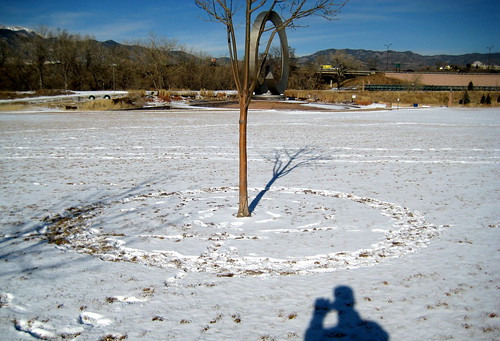After eight years of studying Jiulong Bagua, I finally attended a private training session at the Gompa headquarters in Arlignton, TX. Though I had visited three times before, for “Founder’s Day” weekends with dozens of students at all levels, this visit was quite a different experience. This time I was with a group of seven, all at a similar level, for four days of intensive personalized training.
From the moment we arrived, we experienced the Gompa’s unique blend of modest old-school charm and modern international scope. Immediately, we were greeted in person by Dr. John Painter, the lineage holder and most senior teacher of the Daoqiquan system. He showed us to our quarters, a large room with sleeper sofas where three of us had signed up for lodging. Known as “the first bed and breakfast internal arts institute in America,” it also serves as the Gompa’s main indoor training room, complete with a traditional Chinese ancestor shrine commemorating key figures from Daoqiquan’s centuries-old past.
As we began to unpack, Dr. Painter introduced us to Winchester, a striped yellow kitten who seemed to have recently joined the Gompa staff. The three of us students passed the rest of the evening eating dinner at a local restaurant, arranging our gear for the morning, and coordinating with fellow students as they arrived at the airport.
In the morning, we cleared the training room by folding up our beds and stowing our luggage, and the other students joined us for a session of meditation and warmup exercises led by Dr. Painter. Following that was a morning session on Jiulong Baguazhang taught by Shifu Bob Castaldo, with a break for lunch and then another Jiulong session filling the afternoon. The topic was “core pressure,” or a method of deriving power primarily from the muscles in the body’s torso and abdomen, rather than the arms. This concept is familiar to all Jiulong studens, but Shifu Castaldo had new ideas to deepen our understanding and improve our abilities. Throughout Friday’s two sessions, two more Saturday, and a final one Sunday morning, we explored Shifu Castaldo’s exercises, sometimes working solo and sometimes with a partner.
By Sunday afternoon, all of us had noticeably improved. Playing “Willow Bends” with the other students, I felt like I was truly moving according to the principles of Jiulong, not just in brief flashes, but for continuous stretches of time that felt natural and easy. Rather than monitoring specific muscles or limbs, I found myself thinking about higher-level concepts such as “connecting” to my partner’s spine and “rooting” their incoming force to my feet. Again, these were old, familiar concepts, but I was pleased to feel them happening more naturally and intuitively than ever before, powered by that feeling of “core pressure.” I could feel all of my partners improving too, moving more smoothly and powerfully and with less tension.
That afternoon, Dr. Painter showed us around Old Fort Worth, a living historic tribute to the Texas cattle trade and cowboy culture. For me, the most memorable moment was our chance encounter with a Wild Bill Hickock impersonator, during which we learned that Dr. Painter had once performed as Wild Bill at the Six Flags amusement park and was thus a walking encyclopedia of Wild Bill knowledge and trivia. He and the impersonator traded facts and stories, with the latter remaining almost entirely in character despite his growing surprise and admiration. Watching these two interact was quite a sight!
The Old Fort Worth episode was just one of the legendary after-hours treats that seem to come with a Gompa stay. There were many lunches, dinners, and “dorm room” hours filled with special tips and rare stories from Dr. Painter or the senior Shifus.
Monday, our training turned to the health practice of Flying Dragon Qigong. Dr. Painter gave us a fascinating morning lecture on the connections between modern medical science and ancient qigong. Then, he spent the afternoon leading us through the qigong set and helping us each improve.
By Monday night, I was thoroughly exhausted! These sessions were not physically strenuous, in the sense of running a marathon or lifting weights, but they required extreme, sustained mental focus. Plus, learning new patterns of movement means asking our muscles to act in unfamiliar combinations, and they tire quickly. Each night, I found myself more wiped out, and by the fourth evening, I was ready to sleep for a month.
But instead, I boarded a plane Tuesday morning and spent the whole flight adding to my notes, hoping to capture as many lessons and insights as possible. And capture I did, enough to keep me busy for quite a while. If you are looking to take your skills to the next level or to get your first taste of real “internal” martial arts, you can’t go wrong with a visit to the Gompa.



